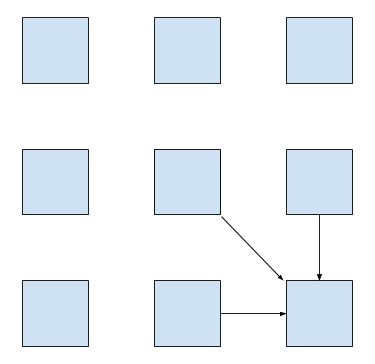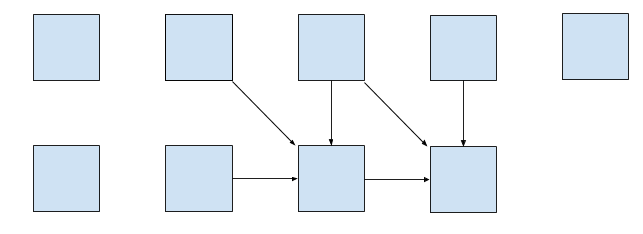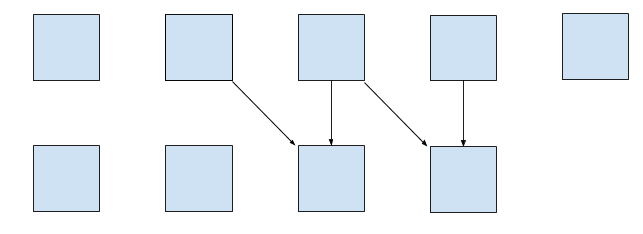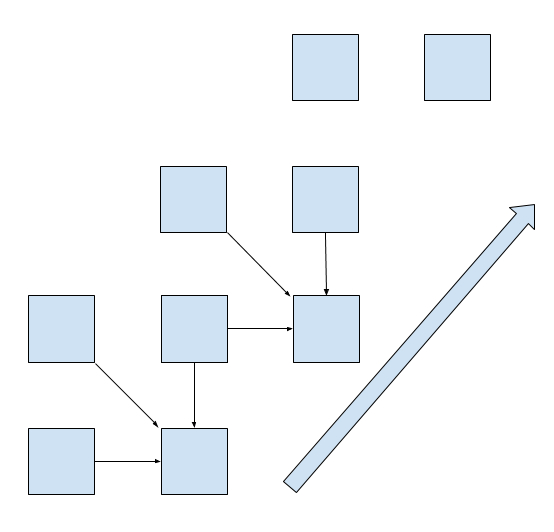Min of Three
How to find a minimum of three double numbers? It may be
surprising to you (it certainly was to me), but there is more than one
way to do it, and with big difference in performance as well. It is
possible to make this simple calculation significantly faster by
utilizing
CPU level parallelism.
The phenomenon described in this blog post was observed in this thread of the Rust forum. I am not the one who found out what is going on, I am just writing it down :)
We will be using Rust, but the language is not important, the original
program was in Java. What will turn out to be important is CPU
architecture. The laptop on which the measurements are done has i7-3612QM.
Test subject
We will be measuring dynamic time warping algorithm. This algorithm calculates a
distance between two real number sequences, xs and
ys. It is very similar to edit distance or Needleman–Wunsch, because it uses the same dynamic programming
structure.
The main equation is
dtw[i, j] =
min(dtw[i-1, j-1], dtw[i, j-1], dtw[i-1, j]) + (xs[i] - ys[j])^2
That is, we calculate the distance between each pair of prefixes of
xs and
ys using the distances from three smaller pairs. This
calculation can be represented as a table where each cell depends on
three others:

It is possible to avoid storing the whole table explicitly. Each row depends only on the previous one, so we need to store only two rows at a time.

Here is the Rust code for this version:
fn dtw(xs: &[f64], ys: &[f64]) -> f64 {
// assume equal lengths for simplicity
assert_eq!(xs.len(), ys.len());
let n = xs.len();
let mut prev = vec![0f64; n + 1];
let mut curr = vec![std::f64::MAX; n + 1];
curr[0] = 0.0;
for ix in 1..(n + 1) {
std::mem::swap(&mut curr, &mut prev);
curr[0] = std::f64::MAX;
for iy in 1..(n + 1) {
let d11 = prev[iy - 1];
let d01 = curr[iy - 1];
let d10 = prev[iy];
// Find the minimum of d11, d01, d10
// by enumerating all the cases.
let d = if d11 < d01 {
if d11 < d10 { d11 } else { d10 }
} else {
if d01 < d10 { d01 } else { d10 }
};
let cost = {
let t = xs[ix - 1] - ys[iy - 1];
t * t
};
curr[iy] = d + cost;
}
}
curr[n]
}
Profile first
Is it fast? If we compile it in --release mode with
[build]
rustflags = "-C target-cpu=native"
in ~/.cargo/config, it takes 435 milliseconds for two
random sequences of length 10000.
What is the bottleneck? Let’s look at the instruction level profile
of the main loop using perf annotate command:
// Find the minimum of three numbers.
0.00 : vmovsd -0x8(%rax,%rsi,8),%xmm1
0.00 : vmovsd (%rax,%rsi,8),%xmm2
0.06 : vminsd %xmm2,%xmm1,%xmm3
9.04 : vminsd %xmm2,%xmm0,%xmm2
0.00 : vcmpltsd %xmm0,%xmm1,%xmm0
22.70 : vblendvpd %xmm0,%xmm3,%xmm2,%xmm0
// Calculate the squared error penalty.
0.00 : vmovsd -0x8(%r12,%r10,8),%xmm1
0.00 : vsubsd -0x8(%r13,%rsi,8),%xmm1,%xmm1
11.01 : vmulsd %xmm1,%xmm1,%xmm1
// Store the result in the `curr` array.
// Note how xmm0 is used on the next iteration.
22.81 : vaddsd %xmm1,%xmm0,%xmm0
10.67 : vmovsd %xmm0,(%rdi,%rsi,8)
perf annotate uses AT&T assembly syntax, this means
that the destination register is on the right.
The xmm0 register holds the value of curr[iy], which was calculated on the previous iteration.
Values of prev[iy - 1] and prev[iy] are
fetched into
xmm1 and xmm2. Note that although the
original code contained three if
expressions, the assembly does not have any jumps and instead uses
two min and one blend instruction to
select the minimum. Nevertheless, a significant amount of time,
according to perf, is spent calculating the minimum.
Optimization
Can we do better? Let’s use min2 function to calculate
minimum of three elements recursively:
fn min2(x: f64, y: f64) -> f64 {
if x < y { x } else { y }
}
fn dtw(xs: &[f64], ys: &[f64]) -> f64 {
// ...
let d = min2(min2(d11, d01), d10);
// ...
}
This version completes in 430 milliseconds, which is a nice win of 5 milliseconds over the first version, but is not that impressive. The assembly looks cleaner though:
0.00 : vmovsd -0x8(%rax,%rsi,8),%xmm1
0.28 : vminsd %xmm0,%xmm1,%xmm0
31.14 : vminsd (%rax,%rsi,8),%xmm0,%xmm0
0.06 : vmovsd -0x8(%r12,%r10,8),%xmm1
0.28 : vsubsd -0x8(%r13,%rsi,8),%xmm1,%xmm1
10.61 : vmulsd %xmm1,%xmm1,%xmm1
23.29 : vaddsd %xmm1,%xmm0,%xmm0
11.11 : vmovsd %xmm0,(%rdi,%rsi,8)
Up to this point it was a rather boring blog post about Rust with some assembly thrown in. But let’s tweak the last variant just a little bit …
fn dtw(xs: &[f64], ys: &[f64]) -> f64 {
// ...
// Swap d10 and d01.
let d = min2(min2(d11, d10), d01);
// ...
}
This version takes only 287 milliseconds to run, which is roughly 1.5 times faster than the previous one! However, the assembly looks almost the same …
0.08 : vmovsd -0x8(%rax,%rsi,8),%xmm1
0.17 : vminsd (%rax,%rsi,8),%xmm1,%xmm1
16.40 : vminsd %xmm0,%xmm1,%xmm0
0.00 : vmovsd -0x8(%r12,%r10,8),%xmm1
0.17 : vsubsd -0x8(%r13,%rsi,8),%xmm1,%xmm1
18.24 : vmulsd %xmm1,%xmm1,%xmm1
17.15 : vaddsd %xmm1,%xmm0,%xmm0
15.82 : vmovsd %xmm0,(%rdi,%rsi,8)
The only difference is that two vminsd instructions are
swapped. But it is definitely much faster.
A possible explanation
A possible explanation is a synergy of CPU level parallelism and speculative execution. It was proposed by @krdln and @vitalyd. I don’t know how to falsify it, but it at least looks plausible to me!
Imagine for a second that instead of vminsd
%xmm0,%xmm1,%xmm0 instruction in the preceding assembly
there is just vmovsd %xmm1,%xmm0. That is, we don’t use
xmm0 from the previous iteration at all! This
corresponds to the following update rule:

The important property of this update rule is that CPU can calculate
two cells simultaneously in parallel, because there is no data
dependency between
curr[i] and curr[i + 1].
We do have vminsd %xmm0,%xmm1,%xmm0, but it is
equivalent to vmovsd %xmm1,%xmm0 if xmm1
is smaller than xmm0. And this is often the case:
xmm1 holds the minimum of upper and diagonal cell, so
it is likely to be less then a single cell to the left. Also, the
diagonal path is taken slightly more often then the two
alternatives, which adds to the bias.
So it looks like the CPU is able to speculatively execute vminsd and parallelise the following computation based on
this speculation! Isn’t that awesome?
Further directions
It’s interesting that we can make the computation truly parallel if we update the cells diagonally:

This is explored in the second part of this post.
Conclusion
Despite the fact that Rust is a high level language, there is a
strong correlation between the source code and the generated
assembly. Small tweaks to the source result in the small changes to
the assembly with potentially big implications for performance.
Also, perf is great!
That’s all :)